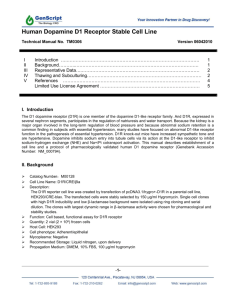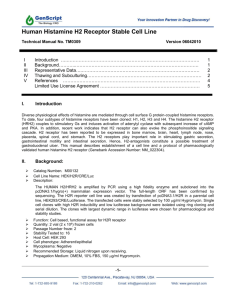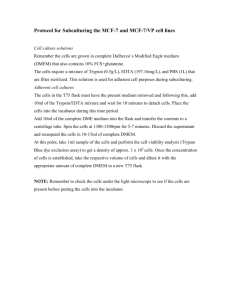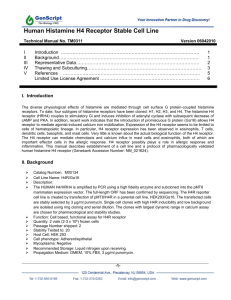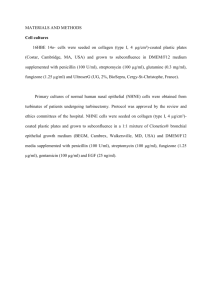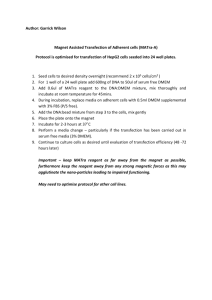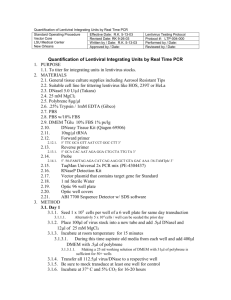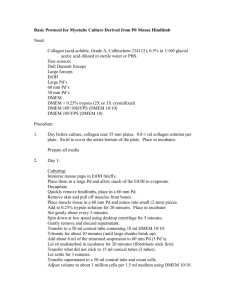Technical Manual No. TM0287 Version 06042010
advertisement
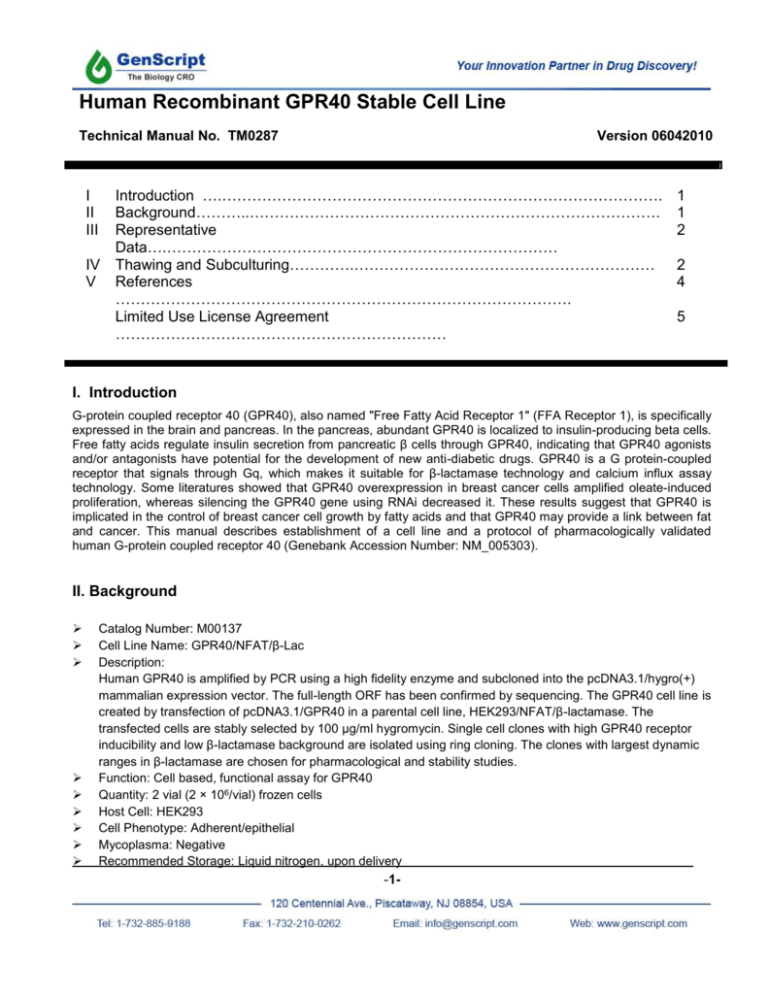
Human Recombinant GPR40 Stable Cell Line Technical Manual No. TM0287 I II III IV V Version 06042010 Introduction ….……………………………………………………………………………. Background………..………………………………………………………………………. Representative Data….…………………………………………………………………… Thawing and Subculturing………….…………………………………………………… References ………………………………………………………………………………. Limited Use License Agreement ………………………………………………………… 1 1 2 2 4 5 I. Introduction G-protein coupled receptor 40 (GPR40), also named "Free Fatty Acid Receptor 1" (FFA Receptor 1), is specifically expressed in the brain and pancreas. In the pancreas, abundant GPR40 is localized to insulin-producing beta cells. Free fatty acids regulate insulin secretion from pancreatic β cells through GPR40, indicating that GPR40 agonists and/or antagonists have potential for the development of new anti-diabetic drugs. GPR40 is a G protein-coupled receptor that signals through Gq, which makes it suitable for β-lactamase technology and calcium influx assay technology. Some literatures showed that GPR40 overexpression in breast cancer cells amplified oleate-induced proliferation, whereas silencing the GPR40 gene using RNAi decreased it. These results suggest that GPR40 is implicated in the control of breast cancer cell growth by fatty acids and that GPR40 may provide a link between fat and cancer. This manual describes establishment of a cell line and a protocol of pharmacologically validated human G-protein coupled receptor 40 (Genebank Accession Number: NM_005303). II. Background Catalog Number: M00137 Cell Line Name: GPR40/NFAT/β-Lac Description: Human GPR40 is amplified by PCR using a high fidelity enzyme and subcloned into the pcDNA3.1/hygro(+) mammalian expression vector. The full-length ORF has been confirmed by sequencing. The GPR40 cell line is created by transfection of pcDNA3.1/GPR40 in a parental cell line, HEK293/NFAT/β-lactamase. The transfected cells are stably selected by 100 μg/ml hygromycin. Single cell clones with high GPR40 receptor inducibility and low β-lactamase background are isolated using ring cloning. The clones with largest dynamic ranges in β-lactamase are chosen for pharmacological and stability studies. Function: Cell based, functional assay for GPR40 Quantity: 2 vial (2 × 106/vial) frozen cells Host Cell: HEK293 Cell Phenotype: Adherent/epithelial Mycoplasma: Negative Recommended Storage: Liquid nitrogen, upon delivery -1- Propagation Medium: DMEM, 10% FBS, 100 μg/ml hygromycin. III. Representative Data Activity (% of Max.) 100 75 EC50=140.6 M 50 25 -5.5 -5.0 -4.5 -4.0 -3.5 -3.0 Log[OA] M 1. Seed 25,000 cells per well in Growth Medium (100 μl per well) into 96-well tissue culture treated blackwall, clear-bottom plates (Costar #3603) after trypsinization. Prepare some wells with medium alone (no cells) to use for determining plate background. 2. Culture cells in 5% CO2 at 37°C. Allow cells to reach ≈90% confluence. 3. 12-24 hours before the assay, replace Growth Medium with 100 μl/well serum-free DMEM. Be careful not to disturb the cells. 4. Prepare ligand solution in serum-free DMEM (10X). 5. Add 10 μl of 10X ligand solution to wells for stimulation and 10 μl of serum-free DMEM per well for nonstimulated control. 6. Incubate cells in 5% CO2 at 37°C for 5-6 hours. 7. Load cells with 2 μM CCF4/AM as described in CCF4 Loading Protocol. 8. Incubate the plate at room temperature for 60-120 minutes without shaking. 9. Read with analyst HT plate reader or observe under fluorescence microscope for 60-200 minutes after CCF-4 loading. V. Thawing and Subculturing Cell Culture Conditions Complete Culture Medium: DMEM: 90%, FBS: 10%, L-glutamine: 2.0 mM, Amp: 100 μg/ml, Strep: 100 μg/ml, hygromycin: 100 μg/ml Serum-free DMEM: Same as above but with no FBS, 0.1% BSA -2- Freezing Medium: Complete culture medium plus 20% FBS and 10% DMSO Thawing Cells: 1. 2. 3. Quickly thaw frozen cells in a 37°C water bath, agitating continuously. Using a 1 ml pipette, slowly pipet the cells up and down five times and add, drop by drop, to a 15 ml centrifuge tube containing 5 ml of fresh prewarmed complete DMEM medium. Then centrifuge at 1,000 rpm for five minutes. Discard the supernatant medium and resuspend the cell pellet in 5 ml of fresh prewarmed complete DMEM medium. Transfer cells to a T25 flask and incubate at 37°C with 5% CO 2 until the cells reach >90% confluence. The recovery rate for frozen cells is usually 90% or above. Subculturing: When the cells reach confluence, they need split. This cell line is normally split twice weekly at 1:8 to 1:15 dilutions. 1. Carefully aspirate all the media. Gently rinse the cell layer with appropriate amount of 0.2% trypsin-EDTA, and aspirate it off. 2. Wait for about 1-3 minutes. Dislodge the cells by gently tapping the sides of flask or dish. 3. Resuspend cells with appropriate amount of complete DMEM medium, and split cells as desired. Changing Medium: This is normally done every other day. 1. 2. Gently aspirate off medium. Transfer fresh warm complete DMEM medium (37°C) into a flask (5 ml for T25 and 10 ml for T75). Freezing Cells: 1. 2. 3. 4. 5. Repeat steps 1-3 of subculturing section. Centrifuge down the cells at 1,000 rpm for five minutes. Aspirate off the supernatant and resuspend the cells in fresh freezing medium at a density of 2-3 × 106 cells/ml. Add 1 ml cells per cryogenic vial. Put the cryogenic vial of cells into cryo freezing container. Then transfer the container to a -80°C environment and leave it there overnight. Transfer cryogenic vial into liquid nitrogen (-196°C). Reagents & Consumables: 1. DMEM: Dulbecco’s Modified Eagle Medium powder, high glucose (Gibco BRL, Cat #12100-046) 2. FBS: Fetal Bovine Serum (Hyclone, Cat #CH30160.03) 3. L-Glutamine: 200 mM (Gibco BRL, Cat # 25030-081) 4. Ampicillin: 50 mg/ml (Sigma A-9518) 5. Streptomycin Sulfate: 50 mg/ml (Gibco BRL, Cat # 11860-038) 6. Hygromycin B in PBS, 50 mg/ml (Invitrogen, Cat #10687-010) 7. Trypsin: 1:250 rom Bovine Pancreas (Gibco BRL, Cat # 27250016) 8. DMSO: dimethyl sulphoxide (Sigma, Cat #D8418) 9. Hepes: Sigma Cat #H-3375 10. CCF4: (Invitrogen, Cat #K1096) -3- 11. Venor@GeM Mycoplasma Detection kit: Minerva Biolabs Cat #11-1050 12. 96 Well Plate: Costar, Cat# 3603, Blackwall/clear bottom, Polystyrene, sterilized. Media and Solutions: 1. PBS (for preparation of 500 ml) 1) KCl: 0.1 g 2) KH2PO4: 0.1 g 3) NaCl: 4.0 g 4) Na2HPO4.12H2O: 1.4425 g Dissolve the above components in double-distilled water (ddH2O) and adjust pH to 7.4 with 0.1 N NaOH. Add ddH2O to the final volume of 500 ml. Autoclave and store at 4°C. 2. Trypsin-EDTA (for preparation of 100 ml) 1) Trypsin: 0.25 g 2) 2%EDTA: 2 ml 3) PBS: 98 ml Dissolve trypsin in 2%EDTA and PBS completely; sterilize the solution by passing through a 0.20 μm membrane filter; store at 4°C. 3. Culture medium 1) 2) 3) 4) 5) (for preparation of 1 L) Measure out 950 ml distilled water to dissolve the media components, stirring gently until the solution becomes clear. Add NaHCO3 3.7 g for high glucose DMEM Adjust pH of medium to 0.2-0.3 below the desired final working pH (using 1 N NaOH or 1 N HCL is recommended). Add slowly while stirring. Dilute to 1 liter with ddH2O. Sterilize the medium immediately using the method of membrane filtration. Store at 4°C 4. Ampicillin/Streptomycin 50 mg/ml Dissolve 1 g ampicillin or streptomycin in 20 ml ddH2O and sterilize the solution by membrane filtration using 0.20 μm filter. Aliquot and store at 4°C for short-term conservation and -20°C for long term conservation. IV. References 1. 2. 3. 4. Briscoe, C. P., M. Tadayyon, et al. (2003). The orphan G protein-coupled receptor GPR40 is activated by medium and long chain fatty acids. J. Biol. Chem. 278(13): 11303-11. Yasuaki Itoh, Yuji Kawamata, et al (2003). Free fatty acids regulate insulin secretion from pancreatic b cells through GPR40. Nature 422(13): 173-176 Steneberg, P., N. Rubins, et al. (2005). The FFA receptor GPR40 links hyperinsulinemia, hepatic steatosis, and impaired glucose homeostasis in mouse. Cell Metab. 1(4): 245-58. Hardy, S., G. G. St-Onge, et al. (2005). Oleate promotes the proliferation of breast cancer cells via the G protein-coupled receptor GPR40. J. Biol. Chem. 280(14): 13285-91. GenScript USA Inc. 120 Centennial Ave., Piscataway, NJ 08854 Tel: 732-885-9188, 732-885-9688 Fax: 732-210-0262, 732-885-5878 -4- Email: info@genscript.com Web: http://www.genscript.com For Research Use Only. Limited Use License Agreement This is a legal agreement between you (Licensee) and GenScript USA Inc. governing use of GenScript's stable cell line products and protocols provided to licensee. By purchasing and using the stable cell line, the buyer agrees to comply with the following terms and conditions of this label license and recognizes and agrees to such restrictions: 1) 2) 3) The products are not transferable and will be used at the site where they were purchased. Transfer to another site owned by buyer will be permitted only upon written request by buyer followed by subsequent written approval by GenScript. The purchaser cannot sell or otherwise transfer (a) this product (b) its components or (c) materials made using this product or its components to a third party. The products sold by GenScript are for laboratory and animal research purposes only. The products are not to be used on humans, for consumption, or for any unlawful uses. GenScript USA Inc. will not assert against the buyer a claim of infringement of patents owned or controlled by GenScript USA Inc. and claiming this product based upon the manufacture, use or sale of a clinical diagnostic, therapeutic and vaccine, or prophylactic product developed in research by the buyer in which this product or its components has been employed, provided that neither this product nor any of its components was used in the manufacture of such product. For information on the use of this product for other purposes, contact Marketing Department, GenScript USA Inc., 120 Centennial Avenue, Piscataway, New Jersey 08840, U.S.A. Phone: 1-732885-9188. Fax: 1-732-210-0262. Email: marketing@genscript.com. -5-
